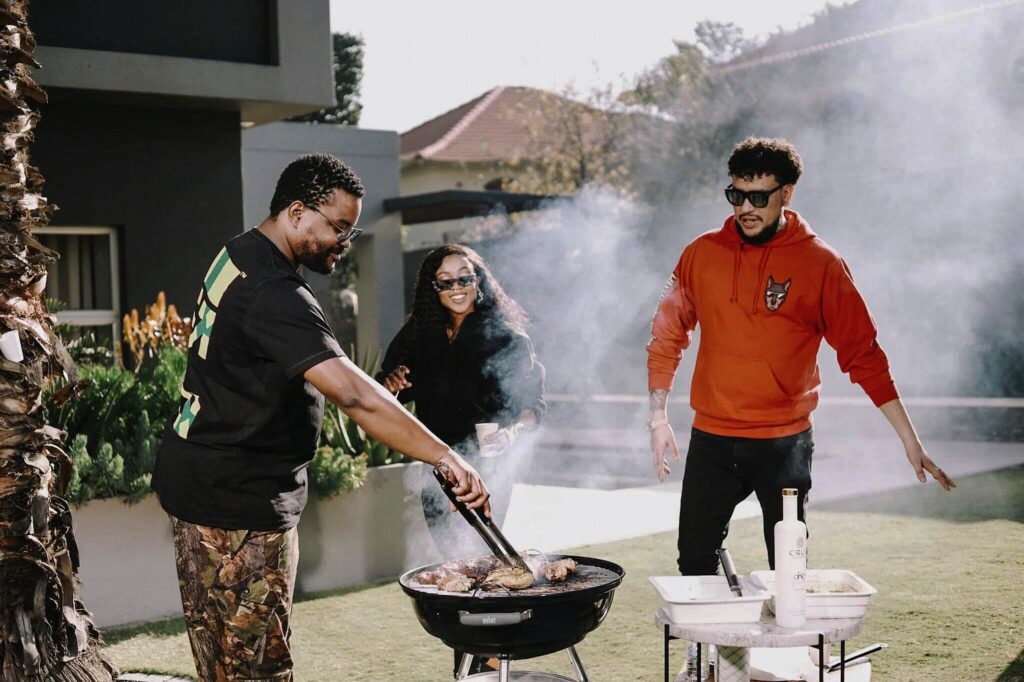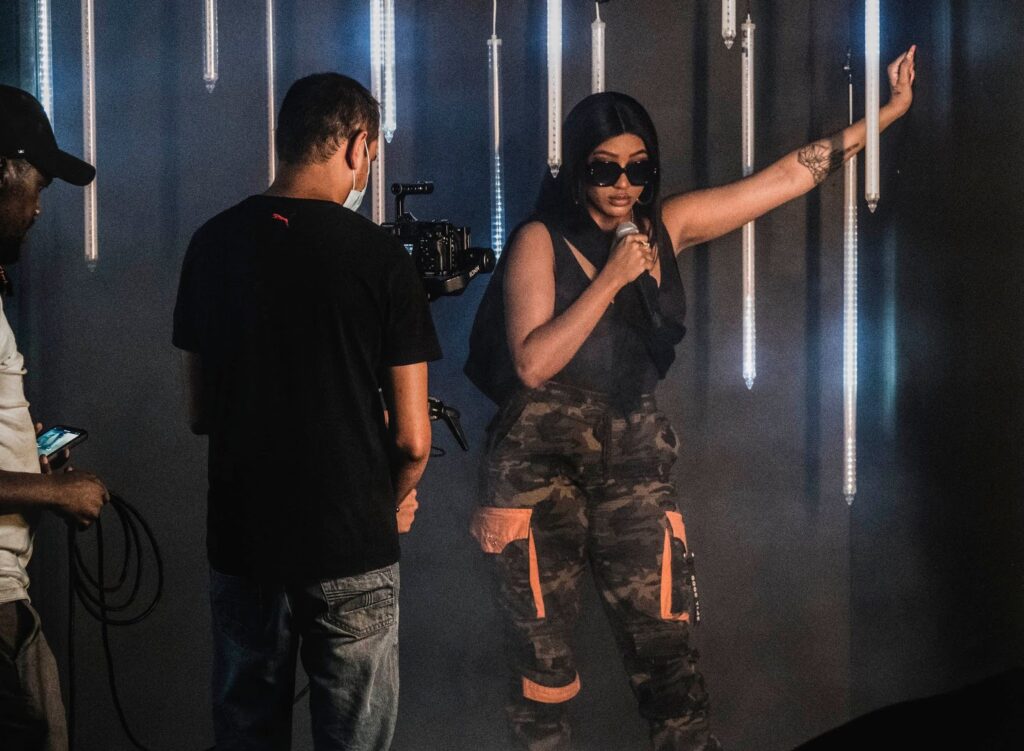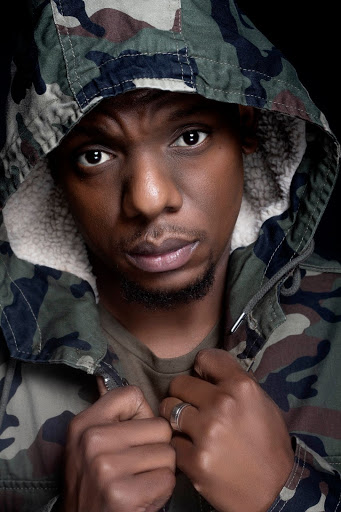A behind-the-scenes shot of Stogie T on the set of Freestyle Friday, which airs on Channel O. (Photo: Songezile Mzakwe)
South African hip-hop artists are catching up to their US counterparts, with a number of them adventuring into media. From Slikour’s website SlikourOnLife to AKA’s TV show The Braai Show With AKA, which airs on SABC 1, and Stogie T’s recently launched Freestyle Friday on Channel O.
Hip-hop artists from abroad have been making a killing in the media space for years. Joe Budden beat respected platforms such as HipHopDX, Complex, The Shade Room, The Breakfast Club and Hot New Hip Hop in the best hip-hop platform category of the 2020 BET hip-hop awards. Artists such as Nas (Mass Appeal), Diddy (Revolt TV) and Jay-Z (Tidal) are investors and stakeholders in media platforms that range from online magazines to TV channels and streaming services.
It’s been happening in South Africa, too, just on a smaller scale. For instance, Spoek Mathambo has been making documentaries on the country’s music scene and the progressive deejay trio Beat Bangaz (DJ Ready D, DJ Azuhl and DJ E20) run their own online radio station, Beat Bangaz Radio.
Between 2017 and 2019, JR’s Feel Good Live Sessions was a platform for some of the country’s and international musicians—Riky Rick, Amanda Black, Bilal, WurlD—to showcase their songs in a series of stripped down acoustic performances.
“Because hip-hop is such a disruptive genre, one of the earliest things you learn when you’re rapping is to kind of colour outside the boxes,” says Stogie T, explaining hip-hop artists’ tendencies to dabble. “You learn to adapt. You learn to figure your way out. So, you might come in as an emcee, but on the other end, you’re a motivational speaker and you’re doing prison talks; or on the other end, you’re a billionaire who’s selling weed legally now. That’s the transformative nature of hip-hop, particularly its practitioners.”
The Braai Show With AKA, a show in which the rapper interviews some of the country’s high-profile personalities over a braai, started airing on SABC 1 in October, and it reportedly pulled in 2.8-million viewers for its first episode, making it one of the most-watched magazine shows on the channel. The show’s first season aired until early 2021, to growing fanfare.
 Sbudaroc and Moozlie on the AKA TV programme The Braai Show, which also aired on SABC 1. (Image courtesy of @AKAApp)
Sbudaroc and Moozlie on the AKA TV programme The Braai Show, which also aired on SABC 1. (Image courtesy of @AKAApp)
The Braai Show premiered online in August. It was one among a lineup of shows available on AKA’s personal app, AKA TV. The app was launched in May, about two months after South Africa was placed on lockdown.
For a fee of R49 a month, subscribers got access to AKA TV shows such as The Braai Show, The Supa Mega Show and AKA’s Orchestra On The Square Show — all centred on AKA’s activities.
In an interview a few weeks after the launch of the app, AKA stated that he had spent about R5-million on a particular upcoming show. “It’s an actual TV production, just like a Channel O and MTV Base would do, but this time it’s on an AKA platform … A TV-level quality show is going to be the only way we keep people coming back for more,” he said.
TV on the internet
The Braai Show’s first guest was Transport Minister Fikile Mbalula who spoke to the rapper about shoes, Rolex watches, Pan Africanism, hip-hop and other topics. Six more episodes of The Braai Show would be uploaded to the app in subsequent weeks featuring guests such as Moozlie, JR, DJ Tira and Scoop Makhathini. Malusi Gigaba, Prince Kaybee and several other personalities would go on to appear on the show on SABC 1.
 AKA, seen here performing on stage, has been tinkering with the strategic direction of his personal app AKA TV since it launched in May 2020. (Image courtesy of @AKAApp)
AKA, seen here performing on stage, has been tinkering with the strategic direction of his personal app AKA TV since it launched in May 2020. (Image courtesy of @AKAApp)
Just like AKA’s show, Freestyle Friday started online. During the content boom that took place as a result of the country’s hard lockdown in 2020, Stogie T threw down a weekly challenge to his fellow rappers. Every week, he would pick a beat, rap over it and pass it on to a select number of rappers to do the same. The videos were rolled out on Friday on social media and, as fans watched and engaged with the videos, #FreestyleFriday became a weekly trend.
This bar fest produced viral freestyles from, among others, Stogie T himself, AKA, ZuluMecca, Kwesta, Kid Tini and Ginger Trill.
Freestyle Friday’s popularity online led to Channel O approaching the emcee to turn it into a TV show. Initially, it was brands that showed interest, because Freestyle Friday was viewed as just online content like a lot of artists’ challenges and self-curated content.
“We [hip-hop artists] have always lived in the marketplace,” says Stogie T. “Hip-hop has been a pioneer in the digital space globally. And even locally, minus monetisation—we were always at the forefront of little technological habits; [for instance, the free file-hosting website] DataFileHost. Now we’re realising that there’s a way to monetise and control this thing.”
 Nadia Nakai rocking the mic on Stogie T’s Freestyle Friday, which started as a self-produced internet series initiated during lockdown in 2020. (Photo: Songezile Mzakwe)
Nadia Nakai rocking the mic on Stogie T’s Freestyle Friday, which started as a self-produced internet series initiated during lockdown in 2020. (Photo: Songezile Mzakwe)
If there’s an artist whose media company has achieved this control and monetisation, it’s Slikour with SlikourOnLife, one of the country’s most influential hip-hop and subculture websites. In a recent article published on the website detailing how the pandemic has affected his business, Slikour stated he now owns 100% of the company.
“We’ve closed off our financial year last week and, ironically, broke our own profitability records since the inception of SlikourOnLife as a business,” he said.
SlikourOnLife’s influence was immortalised by Nasty C rapping, “They should have told you to stay off Twitter, ’cause lately, it’s been looking like I paid off Slikour,” referring to his popularity on the website in the 2016 song Bang Out.
In its early days, SlikourOnLife was the rapper and entrepreneur’s personal blog on which he shared new music and his views on the hip-hop scene.
personal blog in which he shared new music and his views on the hip-hop scene.
With no one to answer to, Slikour ran his platform how he pleased. In 2014, he told IOL: “I am not a blogger, but I love the music, so if I am going to write it with my bad writing skills, know that I did it for the music. I haven’t even scratched the surface, as it is a five-year plan.”
More than five years later, SlikourOnLife has shown some improvement from what it was. Longform editorial content is still not one of the website’s offerings — the focus is, instead, on news, which is covered by a team of young writers who are immersed in the subculture and current music trends.
 Slikour’s online platform SlikourOnLife has managed to flourish (of course, not without challenges) in the largely financially unsustainable space of online media. (Image courtesy of Slikour)
Slikour’s online platform SlikourOnLife has managed to flourish (of course, not without challenges) in the largely financially unsustainable space of online media. (Image courtesy of Slikour)
What gives SlikourOnLife its character, however, are its video shows, which are mostly hosted by artists. For two years, Stogie T was dissecting and ranking verses monthly on the show Verse of the Month, Scoop Makhathini interviews the A-listers of the game on Catching Waves, Reason asks fellow rappers about their craft on Rhyme and Reason, and Slikour himself quizzes artists about their releases and career trajectories on his Balcony Interview series. SlikourOnLife’s latest shows are the popular Spaces, which shows rappers’ living spaces, and On Life Radio, which was launched during the lockdown, and sees him highlight new releases on Instagram.
Unconventional platform
Most of his subjects are artists younger than he is and, during interviews, Slikour tends to go on a bit of a tangent, sharing his insights and knowledge about the industry before posing his questions. It becomes a two-way conversation that ignores the traditional rules of interviewing. Outspoken record executive Nota Baloyi recently criticised Slikour’s interviewing style for “explaining his questions and then answering the questions for the subject”.
The disregard for the profession’s rules may be jarring to watch for a journalism graduate, but SlikourOnLife’s viewers and readers, some of whom are aspiring artists and music industry professionals, watch the videos to soak up as much knowledge about the industry as they can to further advance themselves.
Slikour knows this
In 2016, three years since the website had been founded, he told the hosts of the podcast The Sobering: “They [the artists] allow me [to give them advice]. It’s not me saying to them, ‘I’m Slikour [so you need to listen to me].’ They allow me, and [if] you’re watching as a fan, I think it’s more powerful than me finding you in a corner, and you going, ‘I’m still coming up’ this and that …”
Slikour made it clear during the same interview with The Sobering that what he was building wasn’t a conventional media platform. “[When I started], I said, ‘How do I take something from an informal world and build a formal structure around it?’” he said. “I couldn’t do that with music, I had to build something formal to compete with Naspers, Media24 … and say, ‘You do that, but I know this, and you can’t beat me at that.’”
SlikourOnLife has managed to flourish (of course, not without challenges) in the largely financially unsustainable space of online media. AKA, with his huge following and influence, has evidently been unable to find a working business model for AKA TV yet.
The number of subscriptions the app attracted is unknown, but judging from show episode views, which averaged 1 000, the numbers weren’t sustainable. AKA TV currently has no content, save for a few old trailers. At the moment, the app looks deserted; the home screen displays a static “No post found” message when logging in and subscriptions are frozen.
Clearly, the business model AKA was rethinking when the site went on a hiatus in September involved the migration to traditional media which, even though on a rapid decline, is still the more profitable model in the South African media landscape. Running a TV channel in South Africa is still more sustainable than running a web platform, especially one that relies on subscriptions. In the US, digital media receives investment from venture capitalists, but in South Africa, investments have mostly been made to traditional news outlets.
Convoluted business model
As a result, digital-only platforms such as The Plug, SlikourOnLife, Hype and Zkhiphani are dependent on brand partnerships for revenue. But, without the main subjects — artists — brand partnerships are just ads no one will willingly click on.
And with more artists having bigger followings than media houses, digital culture journalism sites need artists on their side if they are to pull in serious numbers to attract brands to work with them for campaigns. The articles have to be RT-friendly which means little to no “negative” coverage.
 Joe Budden speaking at the Revolt summit in Los Angeles in 2019. (Photos: Phillip Faraone/Getty Images)
Joe Budden speaking at the Revolt summit in Los Angeles in 2019. (Photos: Phillip Faraone/Getty Images)
This convoluted model has created an environment that blacklists platforms for honest and usually well-intentioned criticism. This has led to a dearth of both honest critique and penetrating reviews for artists and their work. As a result, artists get away with unacceptable practices like lifting their US counterparts’ songs, cultural appropriation and coming out with subpar songs and albums, among other practices detrimental to culture.
Hype, in its golden print days, was known for honest album and mixtape reviews, but that practice now only exists in the annals of history. The website now focuses on interviews and news, a model used by most websites that cover music, especially hip-hop.
A media model that’s strictly numbers-driven deems artists, especially those with huge followings, untouchable. With some TV shows struggling to grow their declining viewerships, transplanting shows that are already popular online makes the job of marketers and commissioning editors easy (for worse or for better).
The arithmetic makes sense — the hundreds of thousands of fans who stream AKA’s music and other content followed The Braai Show to the small box. Tweets to AKA’s 4.7-million followers will direct more eyes to SABC 1 than the public broadcaster’s 1.1-million.
The same model applies to the SlikourOnLife YouTube shows — Catching Waves, Speedsta In Da Park, Rhyme and Reason — which were broadcast on Channel O in 2020.
Although the average website or blog has to start from scratch and build its credibility and numbers, artists come with those in-built. And one other advantage that artist-run media platforms have is access.
“I have everyone’s number on my phone, and if I don’t have them, I can get them,” Stogie T admits. “But it’s also about trust because if I call Focalistic and say, ‘Yo, I want to interview you for something,’ I think Focalistic trusts that I won’t waste his time. It won’t be nonsense, because I’m an artist myself so he has a level of respect for me.”
Jaden Smith summed up the future of media in a 2015 tweet: “All Of Your Idols Are Going To Start Writing Their Own Articles, And These Uninformed ‘Journalists’ Will Become Obsolete.”